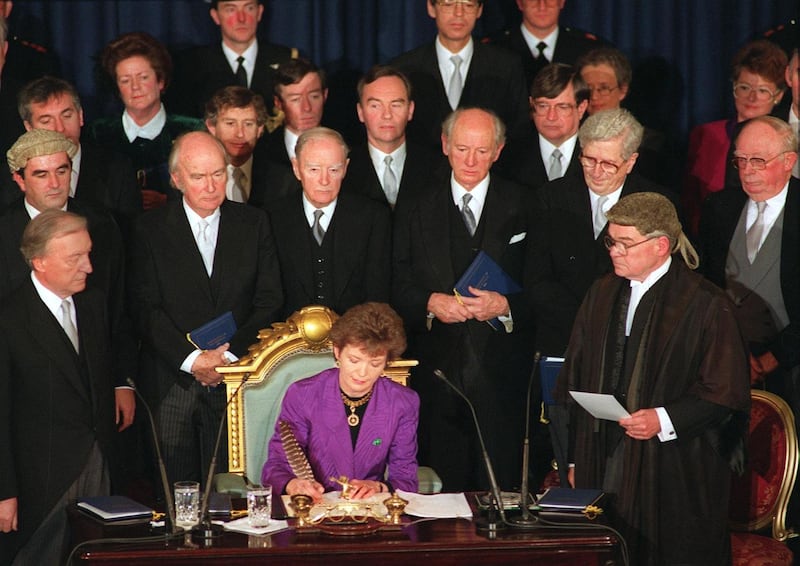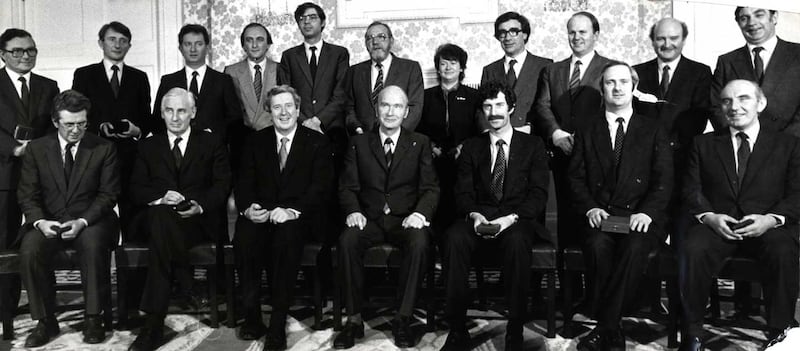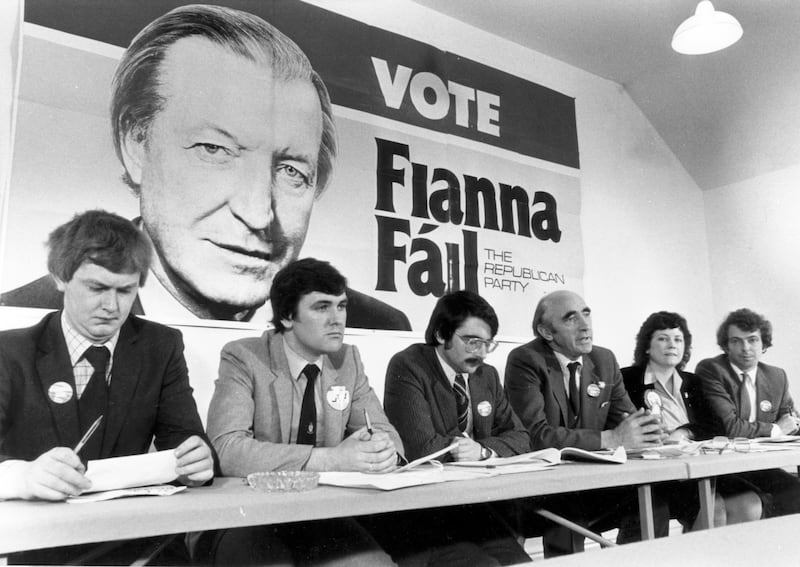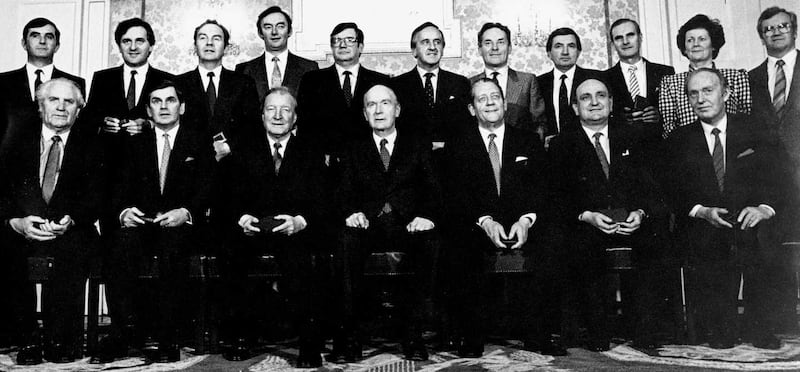In July 2016, 14 women from different backgrounds attended a dinner party in Co Sligo. The women were members of one of Ireland’s most exclusive clubs. What did they all have in common? The 14 represent the majority of women who have served as senior ministers in Irish governments. The answer is not a punchline, it is a stark political reality.
A photograph of the dinner party captures the jovial and celebratory mood of the evening. The 14 women are sitting around a table, while three others (two are deceased and another was unable to attend) are missing from the photograph, one of many taken that night to capture the historic occasion. Their absence, however, could not mitigate the striking symbolism as dinner was served – all the Irish women who have been senior ministers since the first woman was appointed to government in 1919 could be seated around a single dining room table.
Since that evening in July 2016, two more women have been promoted to senior ministerial rank. But the numbers remain meagre, signifying missing female ministers and decades of missed opportunities.
Of the 200 senior ministers in Irish governments from 1919 to September 2018, only 19 have been women. In stark terms, about 90 per cent have been men
When Countess Constance Markievicz was appointed minister for labour in 1919, Ireland – then on the verge of achieving independence – could have been at the forefront in advancing women's representation in political life. In the initial two decades of the 20th century, a woman's right to vote was taken seriously in many countries.
In the UK, after a long and often fraught campaign, legislation was introduced in 1918 starting the process of women's suffrage. Irish women benefited from these changes and in elections in the same year to the House of Commons, Markievicz became the first woman elected as a member of parliament at Westminster. At the time of her election, Markievicz was in prison in England. Having stood on an abstentionist platform, she and her Sinn Féin colleagues never took their seats in the House of Commons. Instead, the first Dáil was formed in Dublin.
In April 1919, Markievicz was appointed a government minister, becoming the first Irish woman to hold a cabinet position. Remarkably, it was 60 years before another woman was appointed to senior ministerial office in Ireland. In 1979, Máire Geoghegan-Quinn of Fianna Fáil was appointed minister for the Gaeltacht, becoming the sole woman among her 14 ministerial colleagues.
This was an experience shared by several subsequent female ministers – Eileen Desmond (Labour, 1981-82), Gemma Hussey (Fine Gael, 1982-87), Mary O'Rourke (Fianna Fáil, 1987-92) and Geoghegan-Quinn herself again (1992-93).
The official photographs of these governments – most of which are in black and white – not only record the historical occasions, but freeze-frame periods in Irish society where men totally dominated positions of power.
It was not until the Fianna Fáil-Labour coalition was formed in January 1993 that two women sat around the cabinet table at the same time (Geoghegan-Quinn and Niamh Bhreathnach). More than 20 years after that underwhelming achievement, the figure doubled to four female ministers in 2014 – the highest level of female cabinet participation since the foundation of the State. The same number of female ministers was included in the governments formed by Enda Kenny in 2016 and Leo Varadkar in 2017.
To put these numbers into perspective, of the 200 people appointed as senior ministers in Irish governments from 1919 up to September 2018, only 19 have been women. In stark terms, about 90 per cent of all Irish senior ministers have been men; almost 10 per cent have been women. It has been a very long and painstakingly slow journey from 1919.
MARY ROBINSON REMEMBERS getting "quite a lot of pushback" when she was seeking to win a Dáil seat in the 1970s and 1980s. Politics aside, she got a lot of flak for being a mother who was seeking election. "You should be at home, minding the child, not coming around," she remembers some voters bluntly remarking.
The political and social climate of the time is important in understanding the challenges she and other women faced on the campaign trail. In the early 1970s, Irish women had to give up their jobs in the public service when they got married. They had to accept lower pay for doing the same work as men. They could not buy contraceptives. They could not refuse to have sex with their husbands.
The list of what today seem incredibly anti-women policies and attitudes went on and on. The position of Irish women was aptly captured in a "job description" printed on the cover of the magazine Bread and Roses, produced by women in UCD in the mid-1970s. It depicted a cartoon of a woman calling out "Girls! Looking for a career? Become a housewife!!!"
Mary Robinson remembers one Catholic priest labelling her a 'Marxist, lesbian bitch' during the presidential campaign in 1990
Against this backdrop, female politicians were, as Nora Owen, a former Fine Gael minister for justice, puts it, "a rare species". In 1973, there were just four female TDs in the Oireachtas. To use Frances Fitzgerald's political barometer, the seven TDs named Michael in the Dáil at the time outnumbered the female representation in the chamber.
Four years later, in 1977, the number of female TDs elected had risen to six – but the number of TDs named Michael was double this. Inside and outside Leinster House, there were restrictions on the role and influence of women in Irish society.
The women who pounded the pavements seeking election in the 1970s and 1980s were trailblazers. Their experiences reveal much about the challenges and changes women faced in Irish society and why so few women were appointed to cabinet during this period.

MARY ROBINSON'S GREATEST TRIUMPH at the ballot box was in the presidential election in 1990.
But when she ran for a Dáil seat in Dublin West in 1981, she was pregnant with her third child: "I was at an early stage of pregnancy. I didn't know when the election would be called, but it was likely to be in May when my baby was due. And of course, this is what happened. Aubrey was born on May 3rd, and the election was called on May 20th."
Polling day was set for June 11th, 1981. Robinson went on the campaign trail with a newborn baby and had to make practical arrangements for breastfeeding. The main thing “was to find safe houses” to feed her son. She recalls the journalist Nell McCafferty spending a day with her out canvassing: “. . . And I thought, ‘oh my God, she’s going to write about this’.”
Practical issues aside, Robinson also faced social judgements on her decision to contest the election. Knocking on doors in Ballyfermot and other areas in the five-seat Dublin West constituency, Robinson was confronted by voters who were "pretty clear that the place of the woman was in the home". Surprisingly, such comments were made by men and women.
During the presidential campaign in 1990, she remembers one Catholic priest labelling her a “Marxist, lesbian bitch”. Rumours about the state of her marriage, which had first circulated when she was trying to win a Dáil seat, also resurfaced: “There were a lot of rumours [...] that Nick and I were divorcing.” She found the gossip about “a sham marriage” during the presidential campaign very hurtful.
In all her electoral contests – Seanad, Dáil and presidential – Robinson was backed by female supporters on the campaign trail. In her first Seanad contest in 1969, most of the women carried out an unglamorous but essential task – they “licked and sticked” stamps on envelopes stuffed with election literature to be sent to voters.
Several years after the end of her term as president, Robinson was in the United States giving a talk in Idaho when a young Irish woman approached her: "When I finished the talk, I saw this youngish woman walking, striding up. I actually came down from the platform, because she had her hand out. She clearly wanted to shake my hand. [The woman said] 'I want to shake your hand, you were my first vote. I was 19-years-old at the time, and when I told my father, he nearly killed me.'"
The whole thing was to say that you can't have a proper democracy without women being strongly represented
"YOU SHOULD BE AT HOME and not be taking a job from a man," one woman told Gemma Hussey, who was a first-time Dáil candidate for Fine Gael in the 1981 general election. Hussey, who served in cabinet from 1982 to 1987, still remembers her response: "I just said to her, 'Look, I will do my best. It's all I can do. I'm not taking a job from anybody.'"
As one of the founders of the Women’s Political Association, Hussey was well able to bat away such remarks. The association emerged in Ireland in the 1970s to encourage more Irish women to stand for election at a time when women’s groups internationally were becoming increasingly vocal about equality issues. The association’s stated target was a “minimum of 40 per cent representation at all levels of policy-making”. Four decades later, that goal has not been achieved.
Looking back, Hussey says: “The whole thing was to say that you can’t have a proper democracy without women being strongly represented. And in Ireland, at the time, we had hardly any women at all [in political life].”
Hussey and other association members felt the need to "talk up" their efforts: "We used to tell the most terrible lies. I remember telling a lie to one journalist in RTÉ. [He asked] 'How many members have you got?' 'Oh, about 1,000', I said, bold as brass. We had about 30. And they were mostly in Dublin. But we decided we would go for broke."

THE ATTITUDE OF SOME SENIOR PARTY OFFICIALS may explain in part why so few women got involved in politics, let alone sought public office.
Former Fianna Fáil minister for justice Máire Geoghegan-Quinn was encouraged that women got actively involved in her by-election campaign in 1975: “They canvassed, did all sorts of stuff for me to get to know people.” But after the election, their work was not recognised within the party: “When the election was over and I went to my first cumann meeting in that area, I walked in the door and I was surrounded by a sea of men.”
As the newly elected TD, Geoghegan-Quinn addressed the meeting and thanked everyone for their support during the by-election campaign. She mentioned her hope for the continued involvement of her female supporters in the local party organisation. The new TD was quickly put in her place: “Now, now, girlie. It’s enough – we have you, a woman as a TD, without having women at meetings. There’s no place for women here.”
There is an irony in that on one hand women were being obstructed in getting involved at the most basic level in local politics, while on the other hand the same party machine had actively campaigned for a female candidate to run for national politics. Party officials specifically sought out Geoghegan-Quinn to run for the Dáil in 1975. She is one of several women with family roots in the political system to have served in cabinet. Her father, Johnny Geoghegan, won a Dáil seat in Galway West in 1954.
The woman has the job outside the home, but she's also the homemaker when she comes home in the evening. In that sense, not an awful lot has changed since my time
Following his death in January 1975, attention quickly moved to the impending by-election: “I’m in my mother’s house – a Saturday or a Sunday afternoon – the doorbell rings. The chairman and the secretary and some other members of the hierarchy in the party in Galway arrive. They go in with my mother into the sitting room. I’m in the kitchen making tea for them. And the next thing, my mother comes out and she said, ‘We want you to come inside’. They thought I would be the best person and the best-known and blah, blah, blah . . .” And so the political career of the second Irish woman appointed to cabinet and a future minister for justice began.
Geoghegan-Quinn says: “In those days – and, indeed, very often nowadays too – you still have a situation where the woman has the job outside the home, but she’s also the homemaker when she comes home in the evening. She still has to do the washing and the cleaning and the cooking, as well as having a job outside the home. And so, in that sense, not an awful lot has changed since my time.”
NEARLY HALF A CENTURY since Máire Geoghegan-Quinn's election, the number of women working outside the home and in the national parliament has increased. However, the number of women in the Dáil has come from a very low base. Just four of the 144 TDs that were elected in 1973 were women – 3 per cent of the total. When Geoghegan-Quinn retained her seat in the 1977 general election, she was joined on the Fianna Fáil backbenches by Síle de Valera, the 22-year-old granddaughter of the party's founder, Éamon de Valera. Geoghegan-Quinn was elevated to cabinet a little over two years later; de Valera's ministerial promotion came two decades later.
At the outset of their careers in Irish national politics, these two women shared similar backgrounds and experiences: professionally, both had qualified as teachers; politically, both came from ‘political dynasties’.

MARY HARNEY'S SURNAME carried no political weight or recognition. When she first ran for the Dáil in 1977, she was a political novice. Harney got an unexpected invitation from party officials who came knocking on her door – or rather calling on "the big public phone" in Trinity College asking, "Could I speak to Mary Harney?" It was, Harney remembers, Séamus Brennan, "saying the [Fianna Fáil] national executive have added me [as a candidate] in Dublin South-East. I said to him, 'Where is Dublin South-East?' And he said, 'Trinity is in Dublin South-East'." Harney was still a student in the college when she contested the general election in 1977.
Her parents gave her £40 and the loan of a bicycle. Fianna Fáil paid for accommodation in a house in Sandymount in the heart of the constituency. Peter Gibson, one of her two male running mates, suggested a novel idea to get media and public attention and boost their profiles: "Peter Gibson, who was a single fella, wanted me to get engaged to him to get publicity. I mean, can you imagine?"
Needless to say, no political or romantic match was made for publicity purposes.
With no political connections to guide her, it took the new candidate a little while to become acquainted with practical matters, such as the boundaries of her new constituency.
During the campaign, her future colleague in the Progressive Democrats Michael McDowell was a Fine Gael activist: “He saw me canvassing on the wrong side of the road. It was the other constituency and he didn’t tell me. I didn’t even know where the constituency was.”
You would knock on a door. A woman would answer the door, and she would say, 'My husband decides the politics in this house'
When she was canvassing within her constituency boundaries, Harney was taken aback by the reaction of many female voters: “You would knock on a door. A woman would answer the door, and she would say, ‘My husband decides the politics in this house’. That was one of the most remarkable things that shocked me as a young woman. She would actually open the door and say, ‘Hold on, my husband decides the politics’. It was just incredible.”
Harney secured a Dáil seat at the second time of asking in Dublin South-West in 1981. Her political CV spanned more than three decades. She contested 10 Dáil elections and failed only once, on her first attempt, to take a seat.
She was first appointed to cabinet in 1997, not just as a government minister but also as the first woman to hold the position of tánaiste. Harney had come a long way from the days of canvassing in the wrong constituency.
In all her election campaigns, Harney says she was helped by women. Her canvassing team was predominantly female: “Over my career, I would say at least 60:40 of the people who canvassed for me were women rather than men, which would be unusual. For the average male candidate, it would be 70:30 [men: women], 80:20 even.”

FOR MARY O'ROURKE, there were practical reasons for having female canvassers. O'Rourke, whose political career began in 1974 when she was elected for Fianna Fáil to Athlone Urban District Council, believes women were an asset on the campaign trail.
She says: “I found them the best campaigners. The guys weren’t as thorough in their canvassing.”
O’Rourke and her team of female canvassers spent more time on the doorsteps, which challenged conventional canvassing rules: don’t waste time and cover as much ground as possible. Despite the time constraints, the approach of O’Rourke and the female members of her team often yielded results, while the pragmatism of her male canvassers had its limitations. The women tended to glean more information during these doorstep conversations: “How many votes are here now? Are there any sons and daughters that are of age for voting? That would be very important. So I noticed they were [more] thorough in their canvassing.”
Several decades later, O’Rourke, now in her 80s, has remained friends with many of the women who knocked on doors for her: “Some have passed away. And the others, I still often meet them. They went out and they wanted to get me elected. But it wasn’t because I was a woman [but] maybe they liked the idea of a woman there.”
Getting voters to open the door in the first place was also a consideration and O'Rourke's party colleague Mary Hanafin states matter-of-factly that female canvassers were more likely to achieve that outcome: "People get more and more anxious about opening doors when there are just men outside. We would always pair off a man and a woman, where possible. They [the voters] are more likely to open the door to a woman." Like O'Rourke, Hanafin is still close to many of the women who canvassed when she was first elected to the Dáil in 1997.
NINETEEN NINETY-TWO was a breakthrough year in Irish politics in terms of the number of women elected to the national parliament. There were 20 women in the Dáil, a record number. Just two years earlier, Mary Robinson had been elected Ireland's first female president. The advancement of women in political life seemed to be gathering pace. However, the promise of rapid growth in the early 1990s stalled as the decade progressed. At the subsequent general election in 1997, the number of female TDs stayed at 20. Nevertheless, 1992 was still a breakthrough of sorts in that a group of women without political connections first entered national politics. Seven of these women went on to serve as senior or junior ministers.
This situation is in sharp contrast to the first generation of female politicians, who primarily had family connections to men who had served in the Oireachtas. The dynasty dynamic started to change in the early 1980s.
"Garret [FitzGerald, Fine Gael leader] brought the first group of women in 1981, the likes of Nuala Fennell [...] and they didn't come from a political background connected with a man," Harney recalls. Nora Owen was among that group of new female Fine Gael TDs in 1981: "Even though I'm a grand-niece of Michael Collins, that wasn't the reason I was elected. We weren't the daughters or the sisters or widows of former TDs. We were elected in our own right. That was a big sea change in 1981."
This was a trend that was to continue.
By the 1992 general election, the majority of the newly elected female TDs, including Niamh Bhreathnach, had, as she puts it, "no political blood in her at all". Two other women first elected in 1992 would later become tánaiste – Labour's Joan Burton (2014-16) and Frances Fitzgerald (2016-17). Harney was the first woman to hold the position, being appointed in 1997 and serving in the role until 2006. Fianna Fáil's Mary Coughlan was tánaiste from 2008 to 2011. Of these four women, only Coughlan comes from a political family – a sign of changing times.
Josepha Madigan was gender-quota candidate. 'I felt that I had a lot more to prove in a sense, because you don't want to be just on a ticket because you are a woman'
AFTER THE 2016 general election, the number of female TDs surpassed the 30 mark for the first time. Both Fine Gael and Fianna Fáil found it a real challenge to reach the 30 per cent gender-quota target for female candidates in 2016. In the end, all the political parties met the quota requirements, but in some cases, proactive measures had to be taken.
Josepha Madigan, who contested her first general election in Dublin-Rathdown in 2016, says: "I was a gender-quota candidate." She has mixed views about it: "I felt that I had a lot more to prove in a sense, because you don't want to be just on a ticket because you are a woman."
Her party colleague, former minister Alan Shatter, failed to get elected and Madigan won the only Fine Gael seat in the constituency: "I like to think that I have proved myself since then in terms of my capabilities rather than people perceiving me just as a female who got on the ticket because she's female."
Madigan's entry into national politics owes much to an approach from Olivia Mitchell, a former Fine Gael TD for Dublin South. Mitchell asked if she would run in the 2014 local elections.
“I remember when she said it to me, I looked behind me to see was she talking to somebody else.” Madigan’s father, who died in 2014, had been a long-time local councillor, first with Fianna Fáil and later as an independent. But despite this family association, she says a career in politics “genuinely hadn’t crossed my mind” as she progressed her legal career.
There are numerous reasons for Madigan's victory. The introduction of gender quotas simply, but critically, ensured she was a Fine Gael candidate. Now Madigan holds the historic distinction of officially being Ireland's first gender-quota candidate to be appointed to cabinet and the 19th Irish woman to serve as a senior minister.
This is an edited extract from Madam Politician: The Women at the Table of Irish Political Power, published by Gill Books, €16.99



















